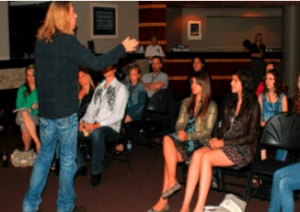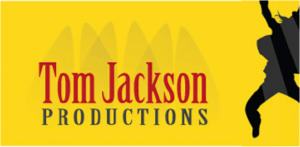Looking at Music – An Interview with Tom Jackson
Tom Jackson is a live music producer with an illustrious track record that includes work for Taylor Swift, Jars of Clay, Jordin Sparks, and Casting Crowns. He is well known too for his many instructional DVDs, where he showcases his method for improving artists’ on-stage presence. Many of the secrets of a good live performance are exposed using his materials, which are analytical and help marry a performer’s emotion to her stagecraft. Anyone that has witnessed Jackson’s clinics–and he recently was a guest at Berklee–cannot fail to be impressed by the importance of the visual element in a commanding musical performance. This sounds paradoxical, but Jackson is a master at what he does.
MBJ: Where did you get your start musically and what lead you into live production?
Tom Jackson: I got my start pretty much like anybody. I lived in Southern California at the time. I liked music, and I picked up the guitar. I played guitar for a while and then realized that I liked the bass more. I played with four bands, toured, and at one point I realized I was tired of the struggle. And one year I just went through this whole thing trying to figure out what I wanted to be when I grew up. And then I just started realizing that, in tour, I had had a lot of “a-ha” moments. I saw things from the audience perspective. I am often asked: “If there is one mistake that musicians make, what is it?” I say: “There is no one thing”. But there is a musicians’ mindset. I think that one of the reasons I can do this job is because I understand what the musician is thinking on stage–but I also am tuned into what the audience is thinking. My job is to make that connection. What a band pays attention to is quite different to the way an audience thinks. A band cares about technique, tone , and more (“Oh my god, the drummer is speeding up). The audience doesn’t care for the same things.
 MBJ: As a musician, do you think being a good performer is something you are born with or is it something you can develop?
MBJ: As a musician, do you think being a good performer is something you are born with or is it something you can develop?
TJ: No. I don’t think you are born with it. It’s like saying are you born a good player. You still have to learn the technique, you still have to learn the theory, and you still have to practice a lot. I have done this almost twenty years, and the first ten years of my life people would come up to me and say, “You know, you can’t teach charisma.” And, initially, I would say, “Yeah, you’re right.” I was too preoccupied with the technical aspects of a performance. But there are things you can do from stage, or places off stage, that are as important as the music. Performing is a craft and that is why I developed my method. After those first ten years I started thinking “What is charisma?” So I broke it down. Charisma comes out of confidence. After confidence comes authority (on stage). And there is a difference between confidence and authority; i.e. someone who takes charge. Charisma comes after that. I make a parallel about performance and music. Things like dynamics , theory, tone , key change, and colors .
MBJ: Could you elaborate?
TJ: I ask this question at every event. How many of you play an hour show? Most people raise their hands. I continue: “In your hour show, do all of your songs sound the same?” And they say, “Well no.” Then I ask “Why is it that if your songs don’t sound the same, they all look the same?” I can hear a pin drop in the room. The players do the same thing from the same place on stage, every song. I mean there might be a slight variation, but that’s what tends to happen. Now, from an audience perspective, it’s insane. It makes no sense at all. We are using all of these dynamics in the song to capture the character of a song musically but we don’t do it physically.
 Now here is the problem: 55% of communication is what the audience sees with their eyes. So if they see the same thing over and over again, the songs start sounding the same. Musicians don’t get it. They say “I am doing this and I am doing that”. But this is not obvious to the audience because audiences are not music experts. So this is where it all goes back to your first question—“ Where did it all begin? “ If you have a song that just completely rocks, it needs movement. It is like an action scene in a movie. You wouldn’t in a million years during a movie think about guys shooting up guns and blowing up things in a kitchen. And then again, you would never think of a love scene being in a car driven 80 mph with guys shooting. The dynamics clearly depend on the scene.
Now here is the problem: 55% of communication is what the audience sees with their eyes. So if they see the same thing over and over again, the songs start sounding the same. Musicians don’t get it. They say “I am doing this and I am doing that”. But this is not obvious to the audience because audiences are not music experts. So this is where it all goes back to your first question—“ Where did it all begin? “ If you have a song that just completely rocks, it needs movement. It is like an action scene in a movie. You wouldn’t in a million years during a movie think about guys shooting up guns and blowing up things in a kitchen. And then again, you would never think of a love scene being in a car driven 80 mph with guys shooting. The dynamics clearly depend on the scene.
MBJ: What is the difference between a live performance arrangement of a song and its studio production?
TJ: Look at the rules for radio: Intro, verse, chorus, verse, chorus, bridge, chorus. This has been the form for the last fifty years. A song will be anywhere from 2:45 to 3:45. And here is the deal: as musicians, if you don’t want to follow this constraint, you’re not going to get played on radio. Goethe says that when “working within limits, mastery reveals itself.”
On radio, you can only develop a vocal line and a hook up to a point. Live, those rules aren’t there. So you have the ability to develop the themes and the characters (the players on stage) way more than the three and a half minute song that people listen to on the radio.
A couple years ago The Simpsons came out with a movie. The Simpsons play a 22- minute sitcom (with 8 minutes of commercials). But when you walk into a movie theatre, your expectations are different to when you are sitting in front of your TV set at home. You are used to going to a movie with a set of expectations. If those expectations are not met, people walk out saying “that wasn’t a great movie.” Now if they exceed those expectations, people say, “great movie.” The same thing holds true with live songs. So, my whole theory is built around rearranging the songs for live performance. An intro on radio is, 5-12 seconds at the most, because if it goes on for too long, people will change the station. That is not the case with live music. In fact, an intro needs to be absolutely compelling so that when you start singing the verse, the audience is with you. Too many people play their old intros (the intro that is on radio) to an audience that doesn’t know them, and the audience does not even catch up to the song until maybe the second verse or second chorus because they are paying attention to other things. They are watching, not just listening. So the idea is to develop the characters and the themes within the song to create a live music experience full of moments.
MBJ: When you spoke about this at the New Music Seminar, you were talking about the spontaneity of a performance and especially in regards to the intro, you were talking about “hanging on the one”. I was curious, what should be planned and what should be spontaneous in the arrangement of a song?
TJ: A song is like a football play. We diagram the play, meaning that in rehearsal we rearrange a song, we have a form but we have certain places for spontaneity in it and we know where those places are.
Are we the artist/band dating our audience or the artist/band married to it? It makes a huge difference. If we are dating the audience, all that happens in the first fifteen seconds is that, as we start playing, people will turn their heads and try to figure out whether they like us or not. If you are dating someone, your relationship with him or her is different so the approach to the show needs to be different. And you have to know what to listen to, and what not to listen to, just like when you are on a date. You might use something as a hook, to see if the girl is still with you. You look for little signals, little touches, and little things that give you clues on whether you are on the right track. If you are, you might open up a bit more, if they are not, you try a little harder. Re-arranging a song is key and you should leave space for spontaneity.
MBJ: What are your experiences with college bands and what advice do you have for them?
TJ: Learn everything you can and play your brains off. But just because you went to a prestigious college doesn’t guarantee that you are going to get a gig. In fact, there are probably forty Berklee alumni I know right here in Nashville, and seven of them are doing drywall. That is why I think what I have to offer, and I don’t mean to sound arrogant, is so important. Great artists pour themselves into a show and what the audience responds to is not just the music.
Musicians are probably thinking that this is not what they are about. I can certainly sit and listen to Pat Metheny all day long. But the attention span of the general public is quite different, and the music is only one of their interests. Luckily, Pat is so good that every musician on the planet loves him and he sells enough records to keep that going. My recommendation is to learn how to pour yourself into your show, so that when you get called to an audition, you are more than just a great player (there are too many of them around). You also need more than the music when the next platform of the business is playing shows live.
By Micah Deterville
www.onstagesuccess.com

Great article! Please direct readers to the http://www.onstagesuccess.com website. That’s the best place for them to find all the information they need to work with Tom or his products.
-OR-
Artists and bands can call or email me for more FREE information.
piper@onstagesuccess.com
615-266-0970
I have been to a couple of Tom Jackson Live Performance seminars. He is brilliant and has taken our show to a much higher level than we could ever figure out by trial and error.
The New York Cowboy